The 2012/2013 NSW trout season opened on Saturday 29 September so you won’t need to wait to have a crack at the trout in New England’s cool clear waters. Seasonally, the winter has been a bit dry, but recent rains have ensured that streams remain in good order.
Before putting together a fly rod and donning the thigh waders and fly vest streamside, there are a couple of things to remember.
Firstly, anglers need a NSW fishing license to fish anywhere in the state, which can be obtained online.
Secondly, nearly all of New England trout waters are on private property and it’s important that permission is obtained before crossing a fence to head to a stream. The general rule is that if a house is within sight of a stream it’s a good place to make a first enquiry.
In general, the highest altitude areas of the New England Tablelands will be best, with the Ebor/Dorrigo localities right at the top of the list. There are at least a dozen streams around Ebor and all hold trout; rainbows and their European cousins the brown trout.
Other good areas for trout are around the towns of Guyra and Glen Innes, almost as far out as Inverell, then further south around Armidale and down to Tamworth. In short the highest areas of the New England plateau.
Trout-inhabited waters are not always easy to find, but NSW Fisheries does offer a comprehensive list of trout streams if you search the net for ‘location of New England trout streams, NSW’.
Surveying a likely stream for the first time, the general rule of thumb is to look for holes that are at least 1m deep with running water. You won’t see the trout by walking along the river and looking, as the fish will hide at your approach, but if you stay at the back of a pool for a spell and just watch carefully, sooner or later there may well be a small dimple or ripple (usually within the bubble trail) that gives away a trout’s location.
Once you know where the fish are holding, it’s then a matter of doing everything just right to connect. And having the correct tackle for the job is important.
Most New England trout range in size from around 250g-1kg. There are a few larger ones taken now and then but they are exceptional; therefore a 5-6wt fly outfit is ideal.
Rivers on the tablelands are not large so long casts are seldom required. A 5wt rod and matching floating line in the hands of an average to good caster will see a fly dropping onto the water like a butterfly with sore feet. Delicacy in casting is a must for trout, which are always attuned to their surroundings. A sloppy cast will usually be rewarded with a total refusal to look at the fly at best; at worst the fish will head instantly for cover.
I usually take a 5wt and a 6wt outfit; both set up with floating lines and rod length tapered leaders with 2kg tippets. I use the 5wt rod mostly, but appreciate the 6wt outfit when strong winds are making casting difficult.
Trout flies are remarkably standard items as they are intended to bare some similarity to food items found in or around streams. There are a number of reliable flies that have always taken trout in the New England streams.
Every trout stream has its mayflies so a separate fly representing the several stages of a mayfly’s development is vital. We have the brown and black nymphs as handy sub surface flies (size 16 and 14) for searching out likely lies at heads of pools, back waters or areas where branches overhang. Cast upstream and fished on an ungreased leader so they sink, these tiny flies will take a lot of trout. You need to watch exactly where the leader is entering the water’s surface. If it draws tight, a fish has taken the fly.
When fish are rising freely, the dry fly comes into its own and flies such as the Adams, Royal Wulff, Watsons Fancy in size 14 or 16 are important. These flies should be fished on a greased leader (Mucilin) and dressed with a floatant, such as gink or the like.
The dry fly is cast above a rising fish, landed as gently as possible, and then allowed to drift into the strike zone. Allowing for a pause before gently lifting to set the hook is the trick to dry fly success.
The sight of a trout rising to an angler’s dry fly is what takes keen fly anglers back to trout water time and again.
Other useful dry flies are the Humpy (size 12) and Elk Hair Caddis (size 14 or 12) and the Red Tag (size 14). All are worth trying when the fish are rising.
When fish don’t seem to be moving much, the wet fly comes into its own. Flies such as the Woolly Bugger in olive, brown or black, tied on size 6 or 8 hooks can be worked carefully downstream with the rod held right on the water to minimise slack. The take is usually a solid tug with the fish leaving the water almost immediately the hook is felt.
All of these flies are commercially available. If a tackle store sells fly fishing gear, flies should also be on hand, labelled, and ready for purchase.
Other useful gear for trout angling will be a vest to keep fly boxes, spare tippet material, fly line floatant and fly dressing within access, a raincoat and pull over in the back pack, along with some tucker. A landing net is also advisable.
A landing net is very important as trout rarely sit calmly when brought to the bank. They jump like crazy, even to the last metre of line, and a net makes it possible to land them without too much difficulty.
I hope you will enjoy the forthcoming trout season as much as I will. I haven’t missed an opening morning since 1978 and I don’t plan to anytime soon.
Reads: 4208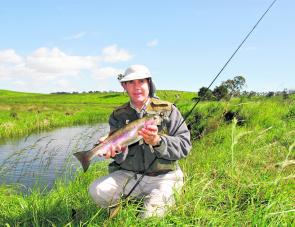
The author with a decent New England rainbow.
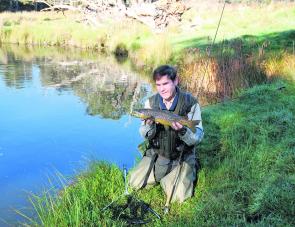
Small water and big fish – the author with a prime Ebor brown trout.
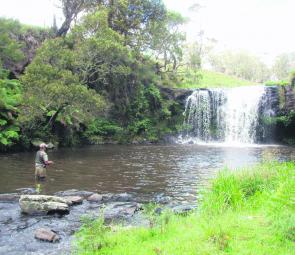
Pools below waterfalls are prime spots for New England trout.
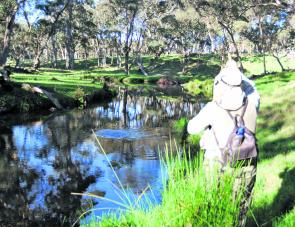
Hook up! A short wait while working the dry fly allows the fish to take the fly properly in its mouth.
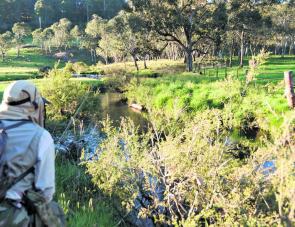
Even small water like this can hold fish up to 1kg, if the fishing pressure has not been too intensive.




